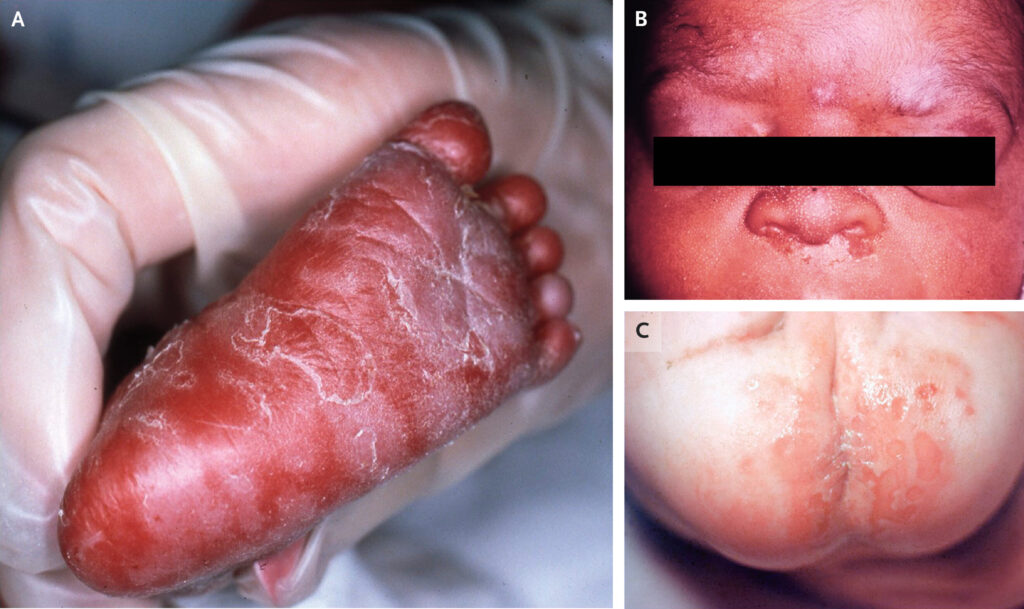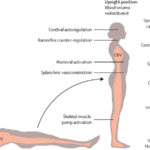Symptomatic congenital syphilis is a severe transplacental infection caused by Treponema pallidum, a spirochete bacterium transmitted from an infected mother to her fetus. It remains a significant public health concern, especially in areas with inadequate prenatal screening and treatment access. The disease manifests with a wide range of clinical symptoms that may present at birth or develop within the first months of life.

Etiology and Transmission of Treponema Pallidum in Neonates
The transmission of Treponema pallidum occurs in utero, typically after the 16th week of gestation. Vertical transmission can result in fetal infection regardless of the stage of maternal syphilis, though primary and secondary stages carry the highest risk.
Mechanism of Fetal Infection:
- Transplacental entry of T. pallidum
- Hematogenous spread to fetal organs
- Inflammatory and fibrotic changes in multiple systems
Clinical Manifestations of Symptomatic Congenital Syphilis
Early-Onset Symptoms (Present at Birth to 2 Years)
Early congenital syphilis symptoms are typically inflammatory and systemic:
- Snuffles: Mucopurulent nasal discharge highly infectious
- Hepatosplenomegaly: Due to spirochete-induced inflammation
- Maculopapular Rash: Especially on palms and soles
- Jaundice: Related to liver dysfunction
- Anemia and Thrombocytopenia
- Pseudoparalysis of Parrot: Painful limb movement from osteochondritis
- Periostitis and Osteochondritis: Radiographic metaphyseal lucencies
Late-Onset Manifestations (After 2 Years)
If untreated, late congenital syphilis can develop, often with irreversible damage:
- Frontal bossing
- Hutchinson teeth: Peg-shaped upper central incisors
- Saddle nose deformity
- Interstitial keratitis: Can lead to blindness
- Clutton’s joints: Painless, symmetrical joint swelling
- Sensorineural deafness
Diagnostic Criteria for Congenital Syphilis in Infants
Maternal Evaluation
- Positive nontreponemal test (e.g., RPR, VDRL) during pregnancy
- Inadequate or no treatment prior to delivery
- Lack of fourfold decline in titer
Neonatal Evaluation
- Serologic Testing:
- Nontreponemal test (infant titer ≥4× maternal titer is significant)
- Treponemal-specific tests (FTA-ABS, TP-PA)
- Direct Detection:
- Darkfield microscopy or PCR from nasal discharge, skin lesions, or placenta
- Additional Studies:
- Long bone radiographs (periostitis, metaphyseal lesions)
- Lumbar puncture (CSF VDRL for neurosyphilis)
- CBC and liver function tests
Recommended Treatment for Symptomatic Congenital Syphilis
First-Line Therapy
- Aqueous Crystalline Penicillin G
- 100,000–150,000 units/kg/day IV, divided every 12 hours (first 7 days), then every 8 hours (for 10 days total)
Alternative Regimens
- Procaine Penicillin G
- 50,000 units/kg IM once daily for 10 days
Incomplete Treatment Consideration
- If treatment is interrupted for more than one day, the entire course must be restarted.
Prognosis and Complications Without Timely Intervention
Delayed or inadequate treatment can result in:
- Neurodevelopmental delay
- Permanent bone deformities
- Blindness or deafness
- Stillbirth or neonatal death
Long-term outcomes are excellent with prompt penicillin therapy and follow-up.
Prevention Strategies: Antenatal Screening and Maternal Management
Universal Maternal Screening
- First prenatal visit
- Third trimester (28–32 weeks)
- At delivery (in high-prevalence regions)
Maternal Treatment
- Benzathine Penicillin G IM
- 2.4 million units in a single dose for early syphilis
- Three doses at weekly intervals for late latent syphilis
Partner Notification and Treatment
- Essential to prevent reinfection and further transmission
Follow-Up and Monitoring Protocols
Post-Treatment Surveillance
- Repeat nontreponemal titers at 3, 6, and 12 months
- Titer decline of fourfold or seroreversion confirms successful therapy
CSF Evaluation
- Necessary for infants with abnormal neurologic signs or abnormal baseline CSF
Radiographic Monitoring
- Repeat imaging for children with significant bone involvement
Public Health Implications and Control Measures
Reporting and Case Management
- All cases must be reported to public health authorities
- Contact tracing, surveillance, and community education campaigns essential
Social Determinants
- Addressing barriers to prenatal care
- Integrating STD screening into maternal health programs
Symptomatic congenital syphilis remains a preventable yet persistent threat. Early identification through rigorous prenatal screening, maternal treatment, and prompt neonatal intervention are the cornerstones of prevention and cure. Comprehensive public health strategies and ongoing education for healthcare providers are critical to reducing the incidence of this devastating disease.

